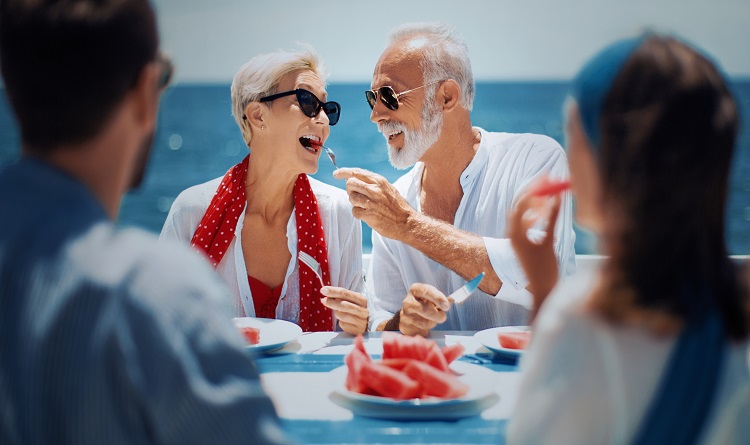Silver economy: Ultimate growth market sparking NPD in F&B

Better healthcare, diets and living conditions are contributing to older, healthier Western consumers. So much so, the population is ageing faster than ever, with those over 60 topping 1bn and rising to 1.4bn by 2023, the World Health Organisation (WHO) says.
What is the silver economy?
The spending power of the silver economy – those aged 50-plus – has often been forgotten as brands and businesses focus on Gen Z. While this powerful generation does have fiscal sway, it lacks the headcount of the older generation.
The silver economy currently represents 28% of Europe’s $13 trillion total spending, which is predicted to reach $16 trillion by 2030, according to World Data Lab.
“Companies and organisations, with operations in Europe, would do well to address the needs of the growing silver economy, a group who are expected in both the short and long-term to hold a significant portion of the continent’s consumption power,” says a World Data Lab spokesperson.
What do silver-economy consumers need?
Though the silver economy is now gaining attention, brands have been slow on the uptake.
“Currently, food and drink brands are failing to monetise this group of consumers, who boast significant spending power,” Jonny Forsyth, director of Mintel Food & Drink, told FoodNavigator. “Over-55s are living longer than ever and lead fuller lives. They need products that meet their age-specific needs, as well as brands which celebrate and understand them.
So, what should food and beverage brands be doing to cater to the needs of older consumers?
First, products must cater to the unique nutritional requirements of older individuals.
“As consumers age, they are likely to require different nutritional intake, due to changes in their bodies,” says Forsyth. “The common food adjustments needed include low sugar, low sodium and low fat.”
And a recent study found older people should also be consuming additional protein much earlier than previously thought.
“Whether fortifying existing food products or taking the more straightforward protein powder route, [manufacturers should] make it as easy as possible for people to get the protein they need without challenging their daily routine, nor indeed their taste buds,” says Daniel Whitehead, founder of The Organic Protein Company. “It’s all about making healthy ageing a breeze, without sacrificing time or the enjoyment of food.”
Thought also needs to be put into packaging design, making it easily accessible, as some people lose motor skills as they age. Some foods should also be produced that are easy to chew and digest. However, this will not be necessary for all members of the silver market, particularly those who are still in their 50s and 60s.
As brands grow and develop ranges for older generations, they may also look to produce products for people with specific health conditions.
“In the future, other aspects responding to the needs of older consumers, such as food for different health conditions – good for kidneys, helps lower cholesterol, etc. – could be considered for innovation, as demand will continue to grow alongside the ageing population,” says Forsyth.
And brands should be careful to avoid lumping all members of the silver economy into one big group.
“The global 55+ cohort is a highly diverse group,” says Forsyth. “Food and drink brands must therefore segment them skilfully according to geography, gender, life stage, income etc.”
The increasing focus on longevity, is also leading to many in the silver economy being referred to as, ‘active agers’. These are a growing number of people in the 55+ group, who proactively maintain their quality of life for as long as possible, through diet and exercise.
“Healthier diets often lead to active agers having a ‘biological age’ that is younger than those of ‘passive agers’,” says Forsyth. “Outlook on life is also important, with active agers emerging as a lucrative target for health-focused brands.”

How countries outside Europe are innovating for the silver economy
While European brands have been slow to spot the potential of the silver economy, those outside Europe have been more on the ball. In Thailand the brand, Creator, produces ready-to-eat meals, specifically for the elderly population, and Chinese brand, Bcareu, has a low-GI range, targeted at seniors with diabetes. There’s even a Brazilian limited-edition Beck’s 70+ beer, designed with ‘senior palates’ in mind.
However, there are a few Europe-based brands catering to the silver economy. In particular, British brand, Mena, produces functional breads, breakfast cereals and snack bars to help combat menopause symptoms. This is done by incorporating ingredients rich in plant oestrogens or phytoestrogens. And founder, Charlotte Blackler, believes it’s inevitable that major brands will sit-up and take notice of the potential.
“It’s only a matter of time before the big boys wake up and just realise it is quite straightforward,” she says. “The quantities are the only thing I can keep secret, but these are normal foods that are quite easy to get hold of and make into cereals or protein bars or other products, and it is just a matter of time before Kellogg’s or Nestle realise that 33% of the people stood in a supermarket could be a target market for this. Until then I’m just making the most of my first mover advantage.”


